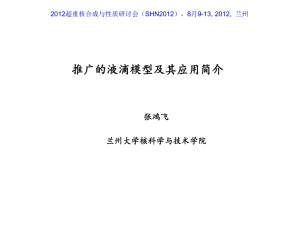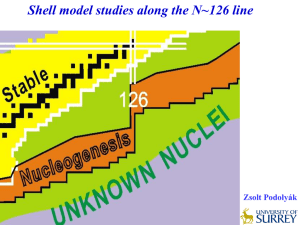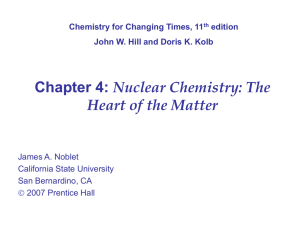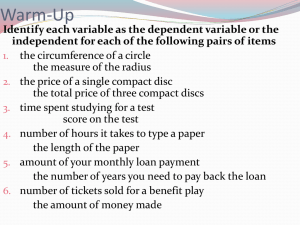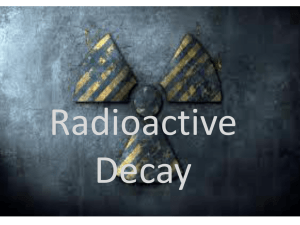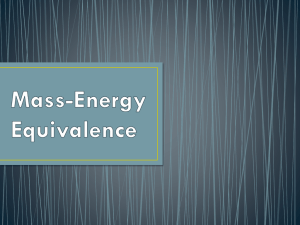Alpha-decay properties of Superheavy nuclei
advertisement
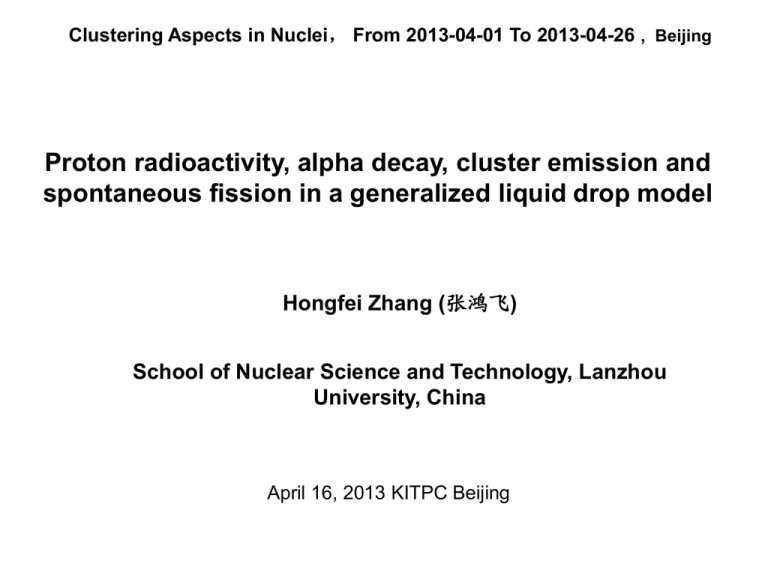
Clustering Aspects in Nuclei, From 2013-04-01 To 2013-04-26 , Beijing Proton radioactivity, alpha decay, cluster emission and spontaneous fission in a generalized liquid drop model Hongfei Zhang (张鸿飞) School of Nuclear Science and Technology, Lanzhou University, China April 16, 2013 KITPC Beijing Outline Model Applications Proton radioactivity Alpha decay Spontaneous fission Cluster emission Summary and outlook Model The potential barriers are constructed by a generalized liquid drop model (GLDM) . (G. Royer and B. Remaud, NPA 444 (1985) 477) E EV ES EC EN Eshell EPair For one body shapes, assuming volume conservation and constant density, the volume, surface and Coulomb energies in this model read: EV (def ) 15.494(1 1.8I 2 ) A(1 0.00377T 2 ) 2 3 ES (def ) 17.9439(1 2.6I ) A (S / 4R0 )(1 1.5T / 17)(1 T / 17) 1 3 2 Z2 1 V( ) R( ) 3 EC e ( ) sin d R0 2 V R0 4 0 5 0 2 2 3 2 For two separated spherical nuclei, EV (def ) 15.494[(1 1.8I12 ) A1 (1 1.8I 22 ) A2 ](1 0.00337T 2 ) 2 3 1 2 3 2 3 1.5 T ES (def ) 17.9439[(1 2.6 I ) A (1 2.6 I ) A ] (1 T )(1 ) 2 17 17 2 1 EC 1 4 0 0.6e Z 2 2 1 2 2 / R1 0.6e 2 Z 22 / R2 e 2 Z1 Z 2 / r The improvements were made for the conventional liquid drop model (a) Quasi-molecular shapes Two parameters s1=a/c1, s2=a/c2 are used to describe the shape evolution The most impressively feature of the quasi-molecular shapes is that it can describe the process of the shapes evolution from one body to two separated fragments in a unified way. (b) Proximity energy The nuclear energy EN has been introduced to take into account the finite-range effects of the nucleon-nucleon force between the close surfaces . (Royer, NPA 444, (1985) 477) 0.9517 (1 2.6 I d2 ) is surface parameter. The introduction of proximity force lowers the barrier of 7.3 MeV, and shifts the peak 2.1 fm towards a more external position for 264Hs. (c) Shell energy W.D.Myers, Droplet Model of Atomic Nuclei (Plenum,New-York, 1977). The Strutinsky method was adopted to calculate Single particle levels ei are calculated in an axially Woods-Saxon potential. Ning Wang and Min Liu, Phys Rev C 81,067302(2010). (d) Pairing energy The pairing energy has been calculated with the following expressions used in a recent version of the Thomas–Fermi model (W.D. Myers and W.J. Swiatecki, Nucl. Phys. A601 (1996) 141) is the ratio of the deformed surface area to the spherical surface area. So the pairing energies vary with Bs along the shapes evolution. Applications 1 Proton radioactivity Decay constant S p 0 P Spectroscopic factor (D.S. Delion, R.J. Liottab, R. Wyssb, Phys. Rep. 424(2006)113 BCS approximation for pairing correlation Blocking method for the unpaired odd nucleon NL3 parameters Junqing Li, Yong Zhou, Zhongyu Ma, Baoqiu Chen, PRC65 (2002)064305 205 83 Bi 2 alpha decay Alpha deacy is the main decay mode for SHN, spontaneous fission is also competitive decay for some heavy nuclei. The known heaviest even-even nucleus decays by alpha emission. For the products Z=114, Z=112, 106,104, spontaneous fission will be competitive with alpha-decay. Phys. Rev. Lett. 104, 142502 (2010) The known heaviest odd-A and odd-odd nuclei are also detected by alpha decay. For the products, the decay mode is still alpha emission up to Rg and Db. It seems that the odd-even effect plays an important role on selecting the decay mode for SHN. The decay mode of 114 isotopes is also isospin dependent. Confirm the odd-even effect is very important for determination of the decay mode. An experimental indication that Z=114 shell closure predicted around N=184. It is an interesting topic to study the competition between alpha-decay and spontaneous fission. Calculations on alpha-decay half-live Viola-Seaborg formulae with Sobiczewski constants (VSS) H.F. Zhang, G. Royer, J.Q. Li, PRC 84 (2011) 027303 Alpha decay process There are two different decay modes for alpha decay in the market, cluster-like and fission-like modes. Cluster-like mode Fission-like mode The experimental investigation can not unambiguously distinguish these two decay modes up to now. In the framework of cluster-like mode (Zhang and Royer, PRC 77, (2008), 054318) (1) (2) (3) (4) The preformation factor P0 of an alpha cluster inside the mother nucleus can be extracted from Eq. (1). The penetration probability plays the most important role to determine the half-life of alpha decay. The preformation factor and assault frequency reflect the nuclear structure features of the mother nucleus. (Zhang and Royer, PRC 77, (2008), 054318) (Zhang and Royer, PRC 77, (2008), 054318) Clearly the closed shell structures play the key role for the preformation mechanism, and more the nucleon number is close to the magic nucleon numbers, the more the preformation of alpha cluster is difficult inside the mother nucleus. Zhang et al., PRC 80, (2009) 057301 In the framework of fission-like mode (Wang, Zhang, Zuo and Li, CPL 27, (2010), 062103) log10v0 Which decay mode should be the actual alpha-decay process, Fission-like mode or cluster-like mode? An approach to deal with the assault frequency Zhang, Royer and Li, PRC 84 (2011) 027303 G is global quantum number. 4, for( N , Z ) 82 g i 5, for82 ( N , Z ) 126 6, for( N , Z ) 126 Zhang, Royer and Li, PRC 84 (2011) 027303 The alpha decay process is rather a radioactivity emission process of an alpha-cluster preformed on the surface of the mother nucleus but before the potential penetration. Alpha-decay properties of Superheavy nuclei To find out the reasonable alpha-decay energy and The new features of SHN. MMM results form Wang et al., PRC 81 (2010) 044322, PRC 82 (2010) 044304. Experimental data from Audi 2012. The RMS deviation with respect to 2149 measured nuclear masses Is 0.441 MeV ( the corresponding results with FRDM is 0.566 MeV). Another impressed improvement is the RMS deviation of 46 SHN is reduced 0.263 MeV ( 0.566 MeV for FRDM ) H.F. Zhang, Y. Gao, N. Wang, J.Q.Li, E.G Zhao, G. Royer, PRC85(2012)014325 One proton separation energies and alpha decay energies of 162 isotones and 184 isotones. H.F. Zhang, Y. Gao, N. Wang, J.Q.Li, E.G Zhao, G. Royer, PRC85 (2012) 014325 Potential energy surface of 270Hs and 298114 by Constrained Relativistic Mean Field theory with the parameters NL3 The nucleus 270Hs is a double sub-magic nucleus and 298114 is a spherical double magic nucleus. H.F. Zhang, Y. Gao, N. Wang, J.Q.Li, E.G Zhao, G. Royer, PRC85 (2012) 014325 Alpha decay life-times of Hs and Z=114 isotopes with WKB penetration probability, and the potential barrier is constructed by the GLDM. The calculated alpha decay half-live of 270Hs is 23.33 second with MMM Q, 15.14 second with experimental Q. For 298114, the calculated alpha decay half-live is 1537588.07 seconds ( about 18 days) with the MMM Q. H.F. Zhang, Y. Gao, N. Wang, J.Q.Li, E.G Zhao, G. Royer, PRC85 (2012) 014325 3 spontaneous fission Ellipsoidal deformation in spontaneous shape sequence Spontaneous fission potential barrier Spontaneous fission potential barrier for 235U It is evident the ellipsoidal deformation will decrease the potential barrier, and the Shell corrections of the fragment will produce the second and third humps. Spontaneous fission half-life J.Randrup, S.E.Larsson, P.Moller, S.G.Nilsson,K.Pomorski and A.Sobiczewski, Phys.Rev.C 13 229(1976). Where k is 14.8. Only several channels (in the bottom of every curve) play the key role to determine the spontaneous fission half-life. The decay constant of the mother nucleus is the summation of all possible spontaneous fission decay constant. Comparison between theoretical (t) and experimental (e) barrier characteristics for actinide nuclei. Ea, Eb and Ec are the first, second and third peak heights while E2 and E3 are the energies of the second and third potential minima relatively to the ground state energy (in MeV). Ea and Eb are consistent with the experimental data. The predicted values of the second minimum energy is a little higher than experimental ones. The still sparse but exciting data for the third barrier are correctly reproduced. The external barrier disappears since the attractive proximity forces can no more compensate for the repulsive Coulomb forces. X.J. Bao, H.F. Zhang, G. Royer, J.Q. Li, Nucl. Phys. A 906 (2013) 1 X.J. Bao, H.F. Zhang, G. Royer, J.Q. Li, Nucl. Phys. A 906 (2013) 1 The logarithm of average deviations of a total of 47 spontaneous fission nuclei is: The average deviation between theoretical spontaneous fission half-life and the experimental ones is less than 100 times. The trend of the theoretical results form [11] follows the experimental ones well, but the values are systematically larger than the experimental data. Our calculated results can reproduce the experimental spontaneous fission half-life better. X.J. Bao, H.F. Zhang, G. Royer, J.Q. Li, Nucl. Phys. A 906 (2013) 1 X.J. Bao, H.F. Zhang, G. Royer, J.Q. Li, Nucl. Phys. A 906 (2013) 1 It is evident, for many superheavy nuclei, the spontaneous fission half-lives are long enough to be measured by the present experimental setups, if the spontaneous fission is the main decay mode. X.J. Bao, H.F. Zhang, G. Royer, J.Q. Li, Nucl. Phys. A 906 (2013) 1 Competition between spontaneous fission and alpha-decay for superheavy nuclei Our calculations can reasonably reproduce the experimental results, and the spontaneous can compete with alpha-decay. The magic neutron number N=184 is clear, and the half-lives decrease quickly after this neutron number. From neutron number N=174 to 186, the alpha-decay half-lives are shorter than spontaneous fission half-lives. These SHN can be identified by their alpha-decay properties. The neutron magic number N=184 is confirmed. 4 Cluster radioactivity Within the preformed cluster model approach, the values of the preformation factors have been deduced from the experimental cluster decay half-lives. Blendowske rule for the spectroscopic factor ( AC 1) / 3 S S Blendowske, Walliser, Phys. Rev. Lett. 61 (1998) 1930 The law according to which the preformation factors follow a simple dependence on the mass of the cluster was confirmed by our calculations. Zhang, Dong, Royer, Zuo, Li, Phys. Rev. C 80 (2009) 037307 Our calculations are consistent with the experimental data and the results from DDM3Y interaction. New possible islands of cluster emitters around the doubly magic nucleus 100Sn and in the proton and neutron ranges, Z = 56–64 and N = 58–72, respectively, have been predicted. . The first experiment concluded the nonobservation of 12C emission by 114Ba [26]. Blendowske, Walliser, Phys. Rev. Lett. 61 (1998) 1930 S S( AC 1) / 3 This rule is not valid for the heavy particle radioactivity for the superheavy nuclei ! Why? Summary and outlook • The proton radioactivity, alpha-decay, spontaneous fission and cluster emission are described by a generalized liquid drop model successfully. • The alpha-decay process is rather a radioactivity emission process of a cluster preformed on the surface of the nucleus but before the potential penetration. • Alpha-decay and spontaneous fission are competitive decay modes for superheavy nuclei. • Refitting the mass formulae, not only include the Volume, Surface, Coulomb energies, but also include the microscopic shell energy, and pairing correlation, then adopt the quasi-molecular shape sequence and proximity to describe the decay properties of the heavy and superheavy nuclei more reasonably. Collaborators G. Royer (Nantes University/IN2P3,France) Junqing Li (李君清), Wei Zuo (左维) (兰州近物所) Zhon-yu Ma (马中玉)、Bao-qiu Chen (陈宝秋)(中国原子能科学研究院) En-guang Zhao (赵恩广) (中科院理论物理研究所) Ning Wang (王宁) (广西师范大学) Yuan Gao (高远) (兰州大学/杭州电子科技大学) 董建敏、王艳召、苏昕宁、张海飞、李晓恒、包小军、王永佳、王佳眉、黄银、 王莎 (兰州大学)。 Thank you !
